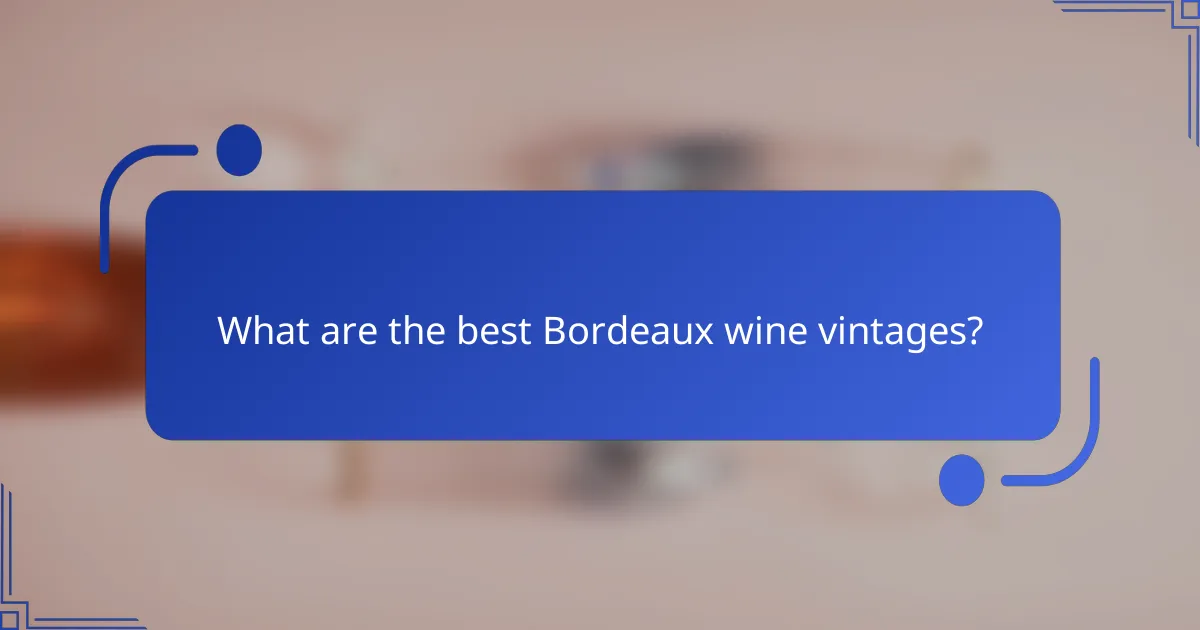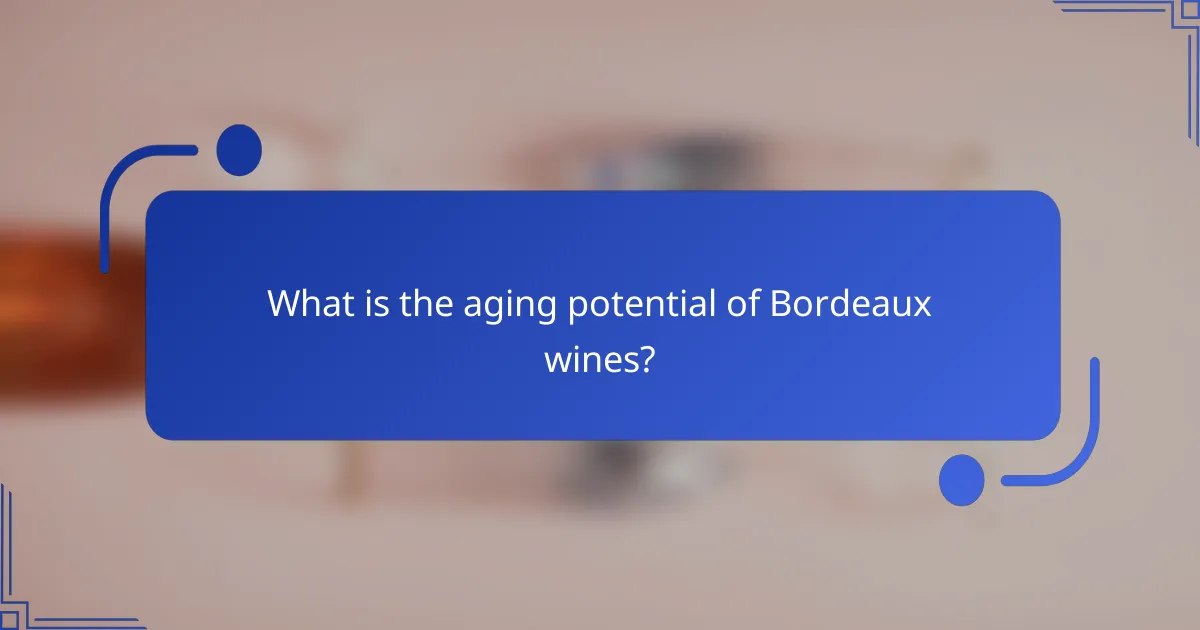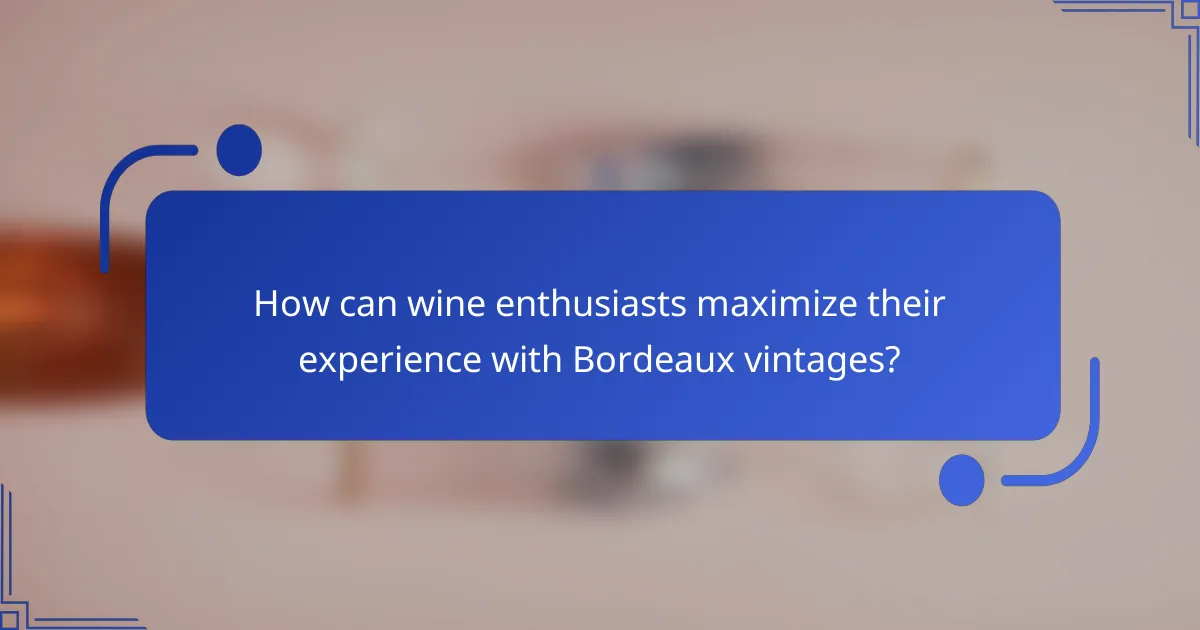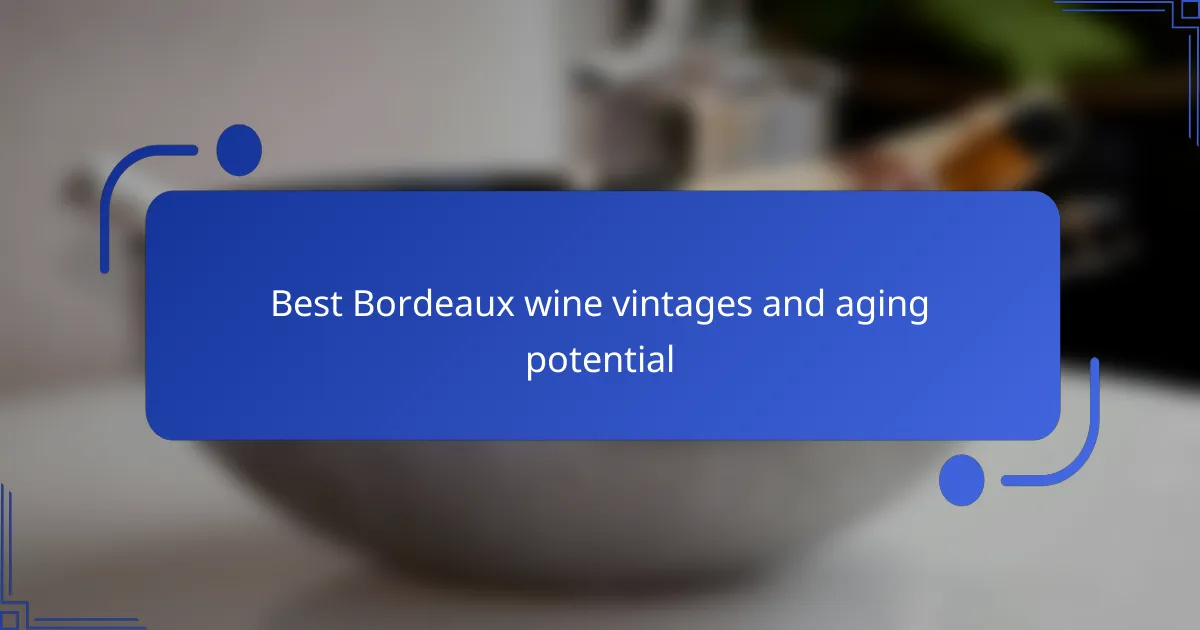
What are the best Bordeaux wine vintages?
The best Bordeaux wine vintages include 2005, 2009, and 2010. The 2005 vintage is renowned for its balance and aging potential. It produced wines with deep color and rich fruit flavors. The 2009 vintage is celebrated for its ripe fruit and smooth tannins. It is often described as opulent and accessible. The 2010 vintage is noted for its structure and longevity. It features high acidity and firm tannins, ideal for aging. Other notable vintages are 1982 and 1996, known for their complexity and aging capacity.
How do vintage years impact the quality of Bordeaux wines?
Vintage years significantly impact the quality of Bordeaux wines. Each vintage reflects the climatic conditions of that year. Factors such as temperature, rainfall, and sunlight influence grape ripening. Optimal weather conditions lead to higher sugar levels and better acidity in grapes. This results in wines with more complex flavors and aromas. Historical data shows that exceptional vintages, like 2005 and 2010, produced wines rated above 95 points by critics. In contrast, poor vintages may yield wines that are less balanced and lower in quality. Thus, vintage years serve as a crucial indicator of a Bordeaux wine’s potential quality and aging capability.
What climatic factors influence Bordeaux wine vintages?
Bordeaux wine vintages are influenced by several climatic factors. Temperature plays a crucial role in grape ripening. Warmer years often lead to higher sugar levels in grapes. Rainfall impacts both grape quality and yield. Adequate rainfall during the growing season is essential for healthy vines. However, excessive rain near harvest can dilute flavors. Sunlight exposure affects the phenolic development of grapes. Regions with optimal sunlight produce more complex wines. Wind patterns can also influence vineyard microclimates. For instance, the moderating effect of the Atlantic Ocean can temper extreme temperatures. Historical records show that specific vintages, such as 2005 and 2010, benefited from ideal climatic conditions. These factors collectively determine the quality and character of Bordeaux wines in each vintage.
How does the aging process affect different Bordeaux vintages?
The aging process significantly affects different Bordeaux vintages by enhancing their complexity and flavor profile. As Bordeaux wines age, tannins soften, resulting in a smoother mouthfeel. Aromas evolve from fruity to more nuanced notes like leather, tobacco, and earth. Older vintages often display greater depth due to the integration of various components.
For instance, a young Bordeaux may present bold fruit flavors, while a well-aged vintage reveals layers of secondary and tertiary aromas. The aging potential varies by vintage, influenced by factors such as grape quality and climatic conditions during the growing season. Historical data shows that vintages like 1982 and 2000 have demonstrated exceptional aging capabilities, often peaking after 15 to 30 years.
Research indicates that proper storage conditions further enhance aging, allowing wines to develop their full potential. Therefore, the aging process is crucial in determining the overall quality and enjoyment of Bordeaux vintages.
Which Bordeaux vintages are considered exceptional?
Exceptional Bordeaux vintages include 1982, 1990, 2000, 2005, 2009, and 2010. These years are renowned for their optimal growing conditions. For instance, the 1982 vintage is celebrated for its rich, ripe fruit and balance. The 1990 vintage is noted for its opulence and complexity. The 2000 vintage is recognized for its structure and aging potential. The 2005 vintage is acclaimed for its concentration and elegance. The 2009 vintage offers lush fruit and accessibility. Lastly, the 2010 vintage is praised for its power and longevity. Each of these vintages has received high ratings from wine experts and critics.
What characteristics define an exceptional Bordeaux vintage?
An exceptional Bordeaux vintage is characterized by optimal weather conditions during the growing season. Ideal temperatures and balanced rainfall lead to healthy grape development. The grapes should achieve full ripeness, resulting in rich flavors and aromas. A harmonious balance of acidity and tannins is essential for aging potential. Exceptional vintages often have a complex flavor profile, including notes of dark fruit, spice, and earthiness. Historical data shows that vintages like 2005 and 2010 are highly regarded for these traits. These vintages demonstrate longevity, with many wines improving over decades. Critical acclaim from wine experts often highlights these characteristics, reinforcing their significance.
How do critics evaluate Bordeaux wine vintages?
Critics evaluate Bordeaux wine vintages based on several key factors. They assess the quality of the grapes, which is influenced by weather conditions during the growing season. Vintage ratings often reflect the overall climate, such as temperature and rainfall. Critics also consider the balance of acidity, tannins, and fruit flavors in the wine. They analyze the aging potential, which indicates how well the wine will develop over time. Historical performance of previous vintages is also taken into account. Ratings often use a numerical scale to provide a quick reference for quality. For example, the 2010 Bordeaux vintage received high praise for its structure and complexity.

What is the aging potential of Bordeaux wines?
Bordeaux wines have significant aging potential, often improving over decades. Many Bordeaux red wines can age from 10 to 30 years or more. The aging potential varies by vintage, grape variety, and specific wine producer. For example, wines from prestigious châteaux like Château Lafite Rothschild can age exceptionally well. The tannin structure and acidity in these wines contribute to their longevity. Historical records show that some Bordeaux wines have been successfully aged for over a century. This longevity is a hallmark of the Bordeaux region’s winemaking tradition. Proper storage conditions further enhance the aging process.
How does aging affect the flavor profile of Bordeaux wines?
Aging significantly enhances the flavor profile of Bordeaux wines. As Bordeaux wines age, they develop complex aromas and flavors. Primary fruit flavors, such as blackberry and plum, evolve into secondary notes like leather and tobacco. Tannins soften over time, leading to a smoother mouthfeel. Acidity remains stable, contributing to the wine’s balance. The aging process also allows for the integration of oak influences, adding vanilla and spice notes. Additionally, bottle aging promotes the development of tertiary flavors, including earthiness and mushroom. Studies show that well-aged Bordeaux wines can achieve peak complexity after 10 to 20 years.
What chemical changes occur during the aging of Bordeaux wines?
During the aging of Bordeaux wines, several chemical changes occur. These changes primarily involve the evolution of phenolic compounds, acids, and aromas. Tannins, which are polyphenolic compounds, soften and polymerize over time. This process enhances the wine’s mouthfeel and reduces astringency.
Additionally, the acidity of the wine decreases, leading to a smoother taste. The oxidation process also occurs, where oxygen interacts with the wine, altering its color and flavor profile. This interaction can lead to the development of complex aromas, including notes of dried fruit, spice, and earth.
Moreover, volatile compounds can form during aging, contributing to the wine’s bouquet. The balance of these compounds is crucial for the overall quality of the wine. Studies indicate that optimal aging can enhance the sensory characteristics of Bordeaux wines, making them more enjoyable.
How long can different Bordeaux wines be aged?
Bordeaux wines can typically be aged for 5 to 30 years, depending on the type and quality. Red Bordeaux wines often have a longer aging potential. High-quality red Bordeaux, such as those from prestigious châteaux, can age for 20 to 30 years. Lesser-quality reds may age well for 5 to 10 years. White Bordeaux wines generally have a shorter aging potential. Most white Bordeaux wines are best consumed within 3 to 7 years. However, some high-quality white Bordeaux can age for up to 15 years. The aging capacity is influenced by factors such as grape variety, vineyard location, and vintage conditions.
What factors determine the aging potential of Bordeaux wines?
The aging potential of Bordeaux wines is determined by several key factors. These factors include grape variety, tannin structure, acidity levels, and storage conditions. Bordeaux wines typically use grape varieties like Cabernet Sauvignon and Merlot, which are known for their longevity. Tannin structure plays a crucial role; higher tannin levels often correlate with better aging potential.
Acidity is another important factor, as wines with higher acidity tend to age better. Proper storage conditions, including temperature and humidity, also significantly influence aging. Studies have shown that wines stored at stable temperatures between 50-55°F (10-13°C) can age more successfully. Additionally, the vintage year impacts aging potential, as weather conditions during the growing season affect grape quality.
In summary, grape variety, tannin structure, acidity, storage conditions, and vintage year collectively determine the aging potential of Bordeaux wines.
How do grape varieties influence the aging potential?
Grape varieties significantly influence the aging potential of wine. Different grape types possess unique characteristics that affect their longevity. For instance, Cabernet Sauvignon is known for its high tannin content, which contributes to better aging. In contrast, Pinot Noir has lower tannins but can develop complex flavors over time. The acidity level in grape varieties also plays a crucial role. Higher acidity can enhance aging potential by preserving freshness. Additionally, the phenolic compounds in grape skins affect color stability and flavor development during aging. Research indicates that wines made from grapes like Merlot and Cabernet Franc can also age well due to their balanced profiles. Overall, the specific attributes of each grape variety determine how well the wine can mature and evolve over time.
What role does the winemaking process play in aging potential?
The winemaking process significantly influences the aging potential of wine. Factors such as fermentation techniques, maceration duration, and oak aging contribute to this potential. During fermentation, yeast activity generates compounds that enhance stability and complexity. Extended maceration extracts tannins and color, which are crucial for aging. The use of oak barrels introduces oxygen, which can soften tannins and develop flavors over time. Additionally, the choice of grape variety impacts aging; certain varietals are more resilient to oxidation. A study by the University of Bordeaux highlights that wines crafted with careful attention to these processes exhibit improved aging characteristics. This evidence underscores the critical role of winemaking in determining a wine’s longevity.

How can wine enthusiasts maximize their experience with Bordeaux vintages?
Wine enthusiasts can maximize their experience with Bordeaux vintages by focusing on proper storage, optimal serving temperature, and food pairings. Proper storage involves keeping bottles in a cool, dark place with consistent humidity. Ideal serving temperature for red Bordeaux is between 60-65°F. Decanting the wine enhances its flavors and aromas. Pairing Bordeaux with complementary foods, such as red meats and aged cheeses, elevates the tasting experience. Additionally, understanding the vintage characteristics aids in appreciating each wine’s unique profile. For example, the 2005 vintage is known for its rich structure and aging potential. Engaging in tastings and discussions with fellow enthusiasts can also deepen appreciation.
What are the best practices for storing Bordeaux wines?
Bordeaux wines should be stored in a cool, dark, and humid environment. Ideal storage temperature ranges between 50°F and 55°F. Consistent temperature is crucial; fluctuations can damage the wine. Humidity levels should be around 70% to prevent cork drying. Bottles should be stored horizontally to keep the cork moist. Vibrations can disturb the wine; thus, a stable location is necessary. Avoid exposure to light, especially sunlight, which can degrade the wine. Proper ventilation is important to prevent mold and odors. These practices ensure optimal aging and preserve the wine’s quality over time.
How does temperature affect the aging of Bordeaux wines?
Temperature significantly impacts the aging of Bordeaux wines. Higher temperatures accelerate chemical reactions in the wine. This can lead to faster maturation but may also result in the loss of desirable flavors. Conversely, lower temperatures slow down aging. This can preserve the wine’s complexity and enhance its longevity. The ideal aging temperature for Bordeaux wines is typically around 55°F (13°C). Fluctuations in temperature can cause expansion and contraction of the wine, potentially damaging the cork seal. Consistent storage conditions are crucial for maintaining wine quality over time. Studies show that wines aged in stable environments develop more favorable characteristics.
What types of containers are ideal for aging Bordeaux wines?
Bordeaux wines are ideally aged in oak barrels. Oak barrels enhance the wine’s flavor and aroma during aging. They allow for micro-oxygenation, which softens tannins and develops complexity. Traditionally, Bordeaux wines use French oak for its subtle influence. The standard barrel size is 225 liters, known as a barrique. These barrels can impart notes of vanilla, spice, and toast. Aging in containers like stainless steel or glass is less common for Bordeaux. These materials do not provide the same flavor integration as oak.
What tips can enhance the enjoyment of aged Bordeaux wines?
Serve aged Bordeaux wines at the optimal temperature of 60-65°F. This temperature range allows the wine’s complex flavors to shine. Use appropriate glassware to enhance aeration and aroma. A large-bowled wine glass can capture the bouquet effectively. Decanting the wine prior to serving can also improve its taste. This process allows the wine to breathe and helps separate sediment. Pair aged Bordeaux with rich foods like red meats or aged cheeses. These pairings complement the wine’s tannins and acidity. Lastly, take your time to savor the wine. Enjoying it slowly can reveal its evolving flavors.
How should aged Bordeaux wines be served for optimal flavor?
Aged Bordeaux wines should be served at a temperature between 60°F to 65°F (15°C to 18°C) for optimal flavor. This temperature range allows the complex aromas and flavors to fully express themselves. Serving at too high a temperature can enhance alcohol perception, overshadowing the wine’s nuances. Conversely, serving too cold can mute the wine’s character.
Decanting aged Bordeaux is also recommended. This process helps aerate the wine and separate it from any sediment. Decanting typically occurs about 30 minutes to an hour before serving. This allows the wine to breathe and enhances its aromatic profile.
Using appropriate glassware is important as well. A wide-bowled glass allows for better aeration and concentration of aromas. The glass should be filled to about one-third full to allow space for the aromas to develop.
These serving guidelines are supported by wine experts and sommeliers, emphasizing the importance of temperature, decanting, and glassware in enhancing the tasting experience of aged Bordeaux wines.
What food pairings complement aged Bordeaux wines best?
Aged Bordeaux wines pair best with rich and flavorful foods. Classic pairings include roasted meats, such as lamb and beef. These meats enhance the wine’s complexity. Game dishes, like venison, also complement aged Bordeaux. Additionally, aged cheeses, particularly hard varieties like Comté, work well. Mushroom dishes can elevate the wine’s earthy notes. Dishes with truffles further enhance the wine experience. These pairings are grounded in culinary tradition and expert recommendations.
The main entity of this article is Bordeaux wine vintages, specifically focusing on their quality and aging potential. The article highlights exceptional vintages such as 2005, 2009, and 2010, detailing how climatic factors and vintage years influence wine quality. It further explores the aging process, including chemical changes that enhance flavor profiles and the impact of grape varieties and winemaking techniques on longevity. Additionally, best practices for storage, serving, and food pairings are provided to maximize the enjoyment of aged Bordeaux wines.
